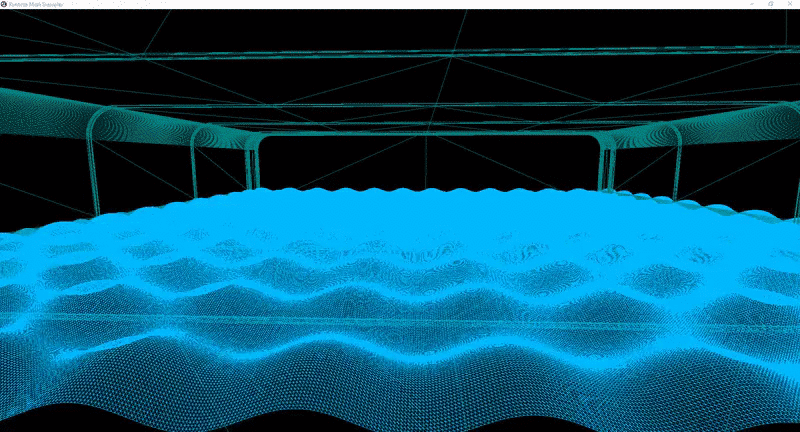https://forums.unrealengine.com/showthread.php?113432-Runtime-Mesh-Component-Rendering-high-performance-runtime-generated-meshes!
Version 2.0 Released!
The RuntimeMeshComponent, or RMC for short, is a component designed specifically to support rendering and collision on meshes generated at runtime. This could be anything from voxel engines like Minecraft, to custom model viewers, or just supporting loading user models for things like modding. It has numerous different features to support most of the normal rendering needs of a game, as well as ability to support both static collision for things such as terrain, as well as dynamic collision for things that need to be able to move and bounce around!
Now, the RMC is very similar in purpose to the ProceduralMeshComponent or CustomMeshComponent currently found in UE4, but it far surpasses both in features, and efficiency! It on average uses half the memory of the ProceduralMeshComponent, while also being more efficient to render, and far faster to update mesh data. This is shown by the ability to update a 600k+ vertex mesh in real time! The RMC is also nearly 100% compatible with the ProceduralMeshComponent, while adding many features above what the PMC offers.
Current list of features in the RMC
- Slicer Support!! You can now use the procedural mesh slicer.
- Collision cooking speed improvements.** (new)
- High precision normals support (new)
- Tessellation support (new)
- Navigation mesh support (new)
- Fully configurable vertex structure (new)
- Ability to save individual sections or the entire RMC to disk (new)
- RMC <-> StaticMeshComponent conversions. SMC -> RMC at runtime or in editor. RMC -> SMC in editor. (new)
- Normal/Tangent calculation. (new) (will be getting speed improvements soon)
- Multiple UV channel support (up to 8 channels)
- Fast path updates for meshes that need to update as fast as frame-by-frame
- Static render path for meshes that don't update frequently, this provides a slightly faster rendering performance.
- Collision only mesh sections.
- 50%+ memory reduction over the ProceduralMeshComponent and CustomMeshComponent
- Visibility and shadowing are configurable per section.
- Separate vertex positions for cases of only needing to update the position.
- Collision has lower overhead compared to ProceduralMeshComponent
** The RMC has picked up the collision cooking improvements done in UE4.14. This means that by default you'll see far faster collision updates, but at the cost of a little lower performance collision. You do however have the option to prioritize quality, which will slow down updates, but make actual collision detection a little faster
As a part of V2, there has also been some preliminary work done on threaded cooking. This can help to unblock the game thread from collision with large meshes. This is still a very new part, and not heavily tested or complete. To use this you'll have to use a source build of the engine. More information to come.
Some requested features that I'm looking into: (These aren't guaranteed to be added)
- LOD (Potentially with dithering support)
- Dithered transitions for mesh updates.
- Mesh sharing, to allow multiple RMCs to have the same copy of the mesh to reduce memory overhead. This is much like how the StaticMeshComponent works.
- Instancing support.
- Multiple vertex buffer (In Addition to the current separate position vertex buffer)
- Mesh replication
Supported Engine Versions:
v1.2 supports engine versions 4.10+
v2.0 supports engine versions 4.12+
The Runtime Mesh Component should support all UE4 platforms.
Collision MAY NOT be available on some platforms (HTML5, Mobile)
Tested Platforms:
Windows, HTML5
(Also tested with HTC Vive, and Oculus Rift)
Downloads:
Version 2.0 (Without Slicer): https://github.com/Koderz/UE4Runtime...eases/tag/v2.0
Version 2.0 (With Slicer): https://github.com/Koderz/UnrealEngi...rmcslicer_v2.0 (You will need to be signed into github and be linked to your UE4 account to access this repo)
Github: https://github.com/Koderz/UE4RuntimeMeshComponent
If you found the RuntimeMeshComponent to be useful to your project, and would like to contribute to its development, please consider a monetary donation! As a student, working on this in his free time, I would greatly appreciate any contribution! To make a donation, simply click the button below! Thank you for your support!

Examples:
https://github.com/Koderz/UE4Runtime...ponentExamples
Documentation:
https://github.com/Koderz/UE4RuntimeMeshComponent/wiki
Issues/Help:
https://github.com/Koderz/UE4Runtime...mponent/issues
640k vertex animated mesh! (Not great quality gif)

Convex collision support for movable objects!

Same familiar API as PMC from Blueprints!

New Simpler to use API from C++! (Still supports the PMC style API as well!)

Last edited by Koderz; 11-28-2016 at 08:20 PM. Reason: v2.0 released!











 Runtime Mesh组件2.0已发布,专为运行时生成的网格提供渲染和碰撞支持,适用于从Minecraft式的体素引擎到用户模型加载等各种场景。相比UE4中的Procedural Mesh Component,在内存使用和渲染效率上有显著提升。
Runtime Mesh组件2.0已发布,专为运行时生成的网格提供渲染和碰撞支持,适用于从Minecraft式的体素引擎到用户模型加载等各种场景。相比UE4中的Procedural Mesh Component,在内存使用和渲染效率上有显著提升。
















 4426
4426

 被折叠的 条评论
为什么被折叠?
被折叠的 条评论
为什么被折叠?








